Introduction
The chest, primarily made up of the pectoral muscles, is one of the most prominent and powerful muscle groups in the human body. Beyond enhancing one’s physical appearance, a robust chest offers functional strength that plays a crucial role in various day-to-day activities and athletic performances. Whether you’re an athlete, a bodybuilder, or someone simply chasing overall fitness, chest exercises are an indispensable part of a comprehensive workout regimen.
As we journey deeper into the realm of chest exercises, it’s pivotal to appreciate the intricacies of technique, the value of variation, and the essence of consistency. Every chest exercise, while focusing on the same muscle group, offers a distinct set of benefits and challenges. To achieve a balanced and holistic chest development, it’s imperative to weave a tapestry of diverse exercises into one’s routine.
Disclaimer
“This article draws its foundation from thorough research, and is intended for informational purposes only. It is not a replacement for medical advice or professional training recommendations. Always consult with a fitness professional or physician before beginning any exercise program.”
15 Best Chest Exercises
- Bench Press (and its variations: incline, decline, flat): What Does the Bench Press Work?
- Push-Up (and its variations: diamond, wide-arm, etc.)How to do:
- Dumbbell Fly
- Dumbbell Press
- Chest Dips
- Pullovers
- Svend Press
- Pec Deck Machine
- Cable Crossover
- Landmine Press
- Resistance Band Chest Press
- Plyometric Push-ups
- Chest Squeeze with Medicine Ball
- Single-arm Dumbbell Bench Press
- Floor Press
1. Bench Press (and its variations: incline, decline, flat): What Does the Bench Press Work?
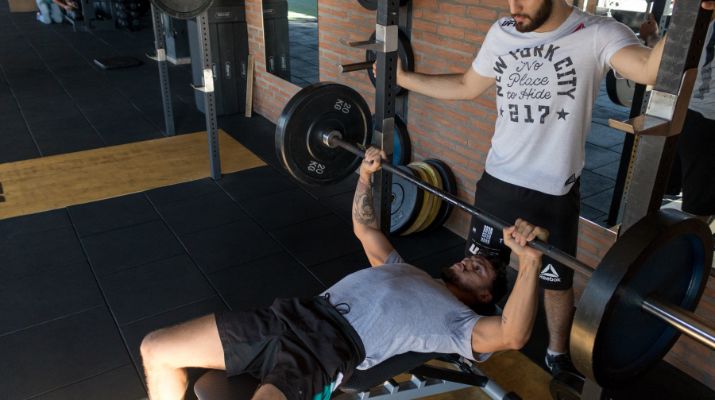
Source by www.pexel.com
How to do:
- Lie down on the bench with your feet flat on the ground. Grip the barbell wider than shoulder-width.
- Unrack the barbell, positioning it above your chest with arms fully extended.
- Inhale and lower the barbell slowly until it’s just above your chest.
- Exhale and push the barbell back up using your chest muscles.
Sets or reps: 3-4 sets of 8-10 reps.
Expert advice: The bench press primarily targets the pectoral muscles. Engage your core throughout the lift, and ensure your lower back has a natural arch with feet firmly planted.
Benefits:
The bench press is a multi-joint exercise working primarily on the chest but also engaging the shoulders and triceps. The variations (incline, decline, flat) allow the targeting of different parts of the pectorals.
- Mistakes: Avoid arching your back excessively or lifting your feet off the ground. Keep the barbell motion controlled to prevent bouncing it off your chest.
- To understand more about compound exercises like the bench press, you might want to check our comprehensive guide on goblet squats.”
2. Push-Up (and its variations: diamond, wide-arm, etc.)How to do:
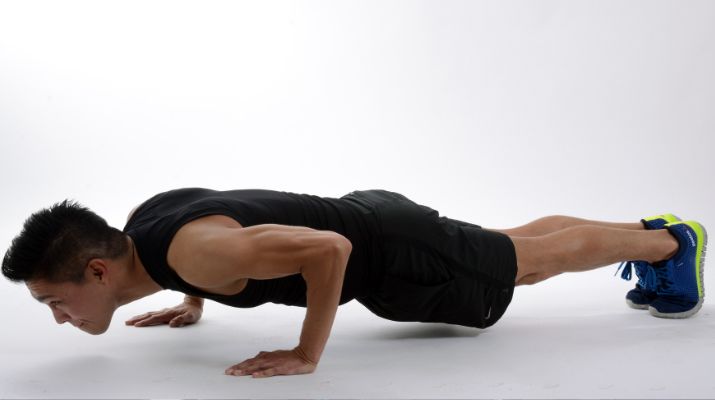
Source by www.pexel.com
- Start in a plank position, hands placed slightly wider than shoulder-width apart.
- Bend your body closer to the ground, keeping your back straight and elbows close to the body.
- Push through your hands, elevating your body back to the starting position.
Variations like the diamond push-up focus more on the triceps, while the wide arm targets the outer chest.
Sets or reps: 3 sets of 10-15 reps, adjusting based on fitness level.
Expert advice: Keep your core engaged throughout the movement and maintain a straight line from head to heels.
Benefits: Push-ups are bodyweight exercises that target the chest, triceps, and shoulders. They also engage the core, making them a holistic upper-body movement.
Mistakes: Avoid sagging your hips or lifting your buttocks too high. Always maintain a neutral neck position.
For another bodyweight exercise that can greatly complement your chest routine, check out our detailed guide on wall pilates.
3. Dumbbell Fly
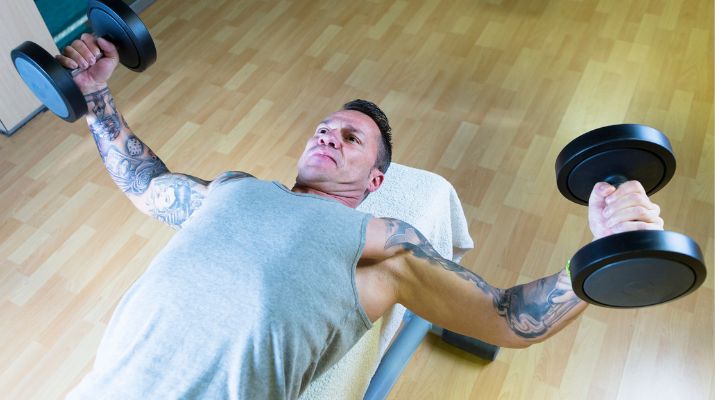
source by canva.com
How to do:
- Assume a prone position on a flat bench, clutching a dumbbell in each hand and extending your arms above your chest.
- With a slight bend in the elbows, Reduce the weights on the outer edges in a broad curve.
- Squeeze the chest muscles and bring the dumbbells back to the starting position.
Sets or reps: 3-4 sets of 8-12 reps.
Expert advice: Always ensure a controlled motion, focusing on the chest contraction rather than the weight lifted.
Benefits: Dumbbell flies isolate the chest muscles, especially the outer pectoral region. They’re excellent for adding width and definition.
Mistakes: Avoid using excessively heavy weights that compromise form. Keep the motion smooth, avoiding any jerky movements.Interlink: Enhance your understanding of targeted exercises with our guide on bicep curls and its variations
4. Dumbbell Press
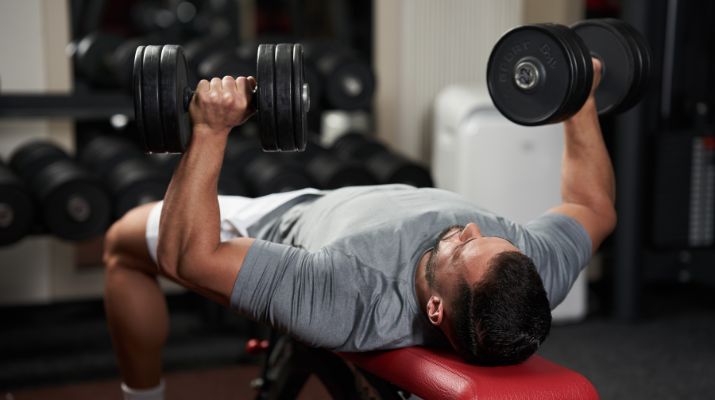
Source by Canve.com
How to do:
- Begin by assuming a prone position on a bench, holding a dumbbell in each hand, palms facing forward, and arms positioned shoulder-width apart.
- Bend your elbows to a 90-degree angle, with the dumbbells aligned at chest height.
- Push the dumbbells up using your chest muscles until your arms are fully extended.
- Slowly lower them back to the starting position.
Sets or reps: 3-4 sets of 8-10 reps.
Expert advice: Focus on squeezing the chest muscles at the top of the movement. Ensure a firm grip on the dumbbells to maintain control throughout the exercise.
Benefits: The dumbbell press targets the middle and upper pectoral muscles. The independent movement of each dumbbell also engages stabilizer muscles, promoting balanced strength and muscle development.
Mistakes: Avoid locking your elbows at the top or letting the dumbbells drift too far apart.
For a better understanding of exercises that focus on muscle symmetry and stabilization, dive into our guide on lunges and their variations.
5. Chest Dips
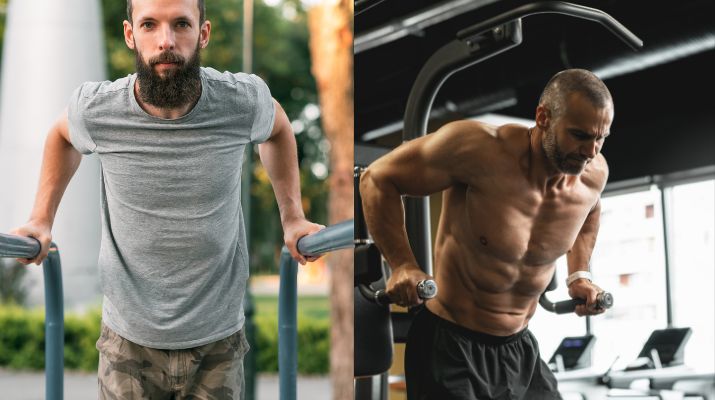
Source by Canva.com
How to do:
- Position yourself between parallel bars, gripping them firmly.
- Push your body upward until your arms are fully extended.
- Lean slightly forward, bending your knees and crossing your ankles.
- Bend at the elbows to bring your upper arms parallel to the ground as you lower your body.
- Push yourself back to the starting position, focusing on using your chest muscles.
Sets or reps: 3 sets of 8-12 reps.
Expert advice: Ensure you maintain a forward lean to target the chest muscles effectively.
Benefits: Chest dips predominantly work the lower pectoral muscles, offering a robust lower-chest workout. Additionally, they engage the triceps and shoulders.
Mistakes: Avoid going too deep, as this may strain the shoulder joints. Keep the movement controlled without using momentum.
To grasp the impact of bodyweight exercises on overall strength and muscle definition, consider checking our guide on calisthenics workouts.
6. Pullovers
How to do:
- Lie perpendicular to a bench with only your shoulders and upper back resting on it. Feet flat on the ground and hips below bench level.
- Hold a dumbbell with both hands above your chest, arms extended.
- Keeping a slight bend in your elbows, lower the weight backward in an arc motion.
- Pull the dumbbell back to the starting position using your chest and lats.
Sets or reps: 3-4 sets of 10-12 reps.
Expert advice: Keep your hips lowered throughout the exercise to increase the stretch of the chest muscles.
Benefits: Pullovers target both the chest and the lats, offering an effective stretch to the pectorals and enhancing chest width.
Mistakes: Avoid using heavy weights that could compromise the form and lead to back strain. Keep the movement slow and controlled.
Enhance your workout regime by exploring the synergistic effects of compound movements with our article on sumo deadlifts.
7. Svend Press
How to do:
- Stand with your feet shoulder-width apart.
- Hold two flat weights (like small plates) together in front of your chest using both hands.
- Press the plates directly out in front of you while squeezing them together.
- Return to the starting position.
Sets or reps: 3 sets of 12-15 reps.
Expert advice: The key to this exercise is maintaining constant pressure between the plates. Focus on engaging your chest muscles throughout.
Benefits: The Svend Press targets the pectoral muscles, particularly emphasizing the inner chest due to the squeezing motion.
Mistakes: Avoid going too heavy and compromising the squeeze between the plates. Ensure your arms remain level with your chest.
Interested in nuanced exercises that target specific muscle groups? Discover more about lat workouts and their benefits.
8. Pec Deck Machine
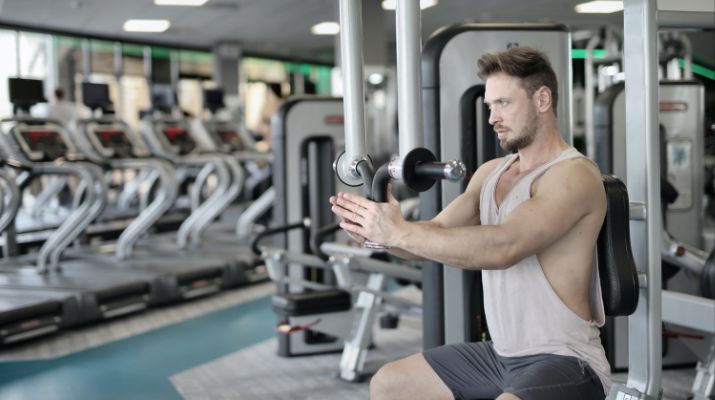
Source by pexel.com
How to do:
- Sit on the pec deck machine with your back firmly against the pad.
- Place your forearms on the padded levers.
- Push the levers together by squeezing your chest.
- Slowly return to the starting position.
Sets or reps: 3-4 sets of 8-12 reps.
Expert advice: Ensure that the seat height aligns the handles with your chest level. Maintain a controlled movement throughout, focusing on the chest squeeze.
Benefits: The pec deck machine isolates and targets the chest muscles, providing excellent contraction and stretch to the pectorals.
Mistakes: Avoid using momentum to push the handles. Also, don’t set the weight so heavy that it limits your range of motion.
Machines can provide targeted workouts. Understand their significance further with our guide on the comparison between hack squat, leg press, and traditional squat.
9. Cable Crossover
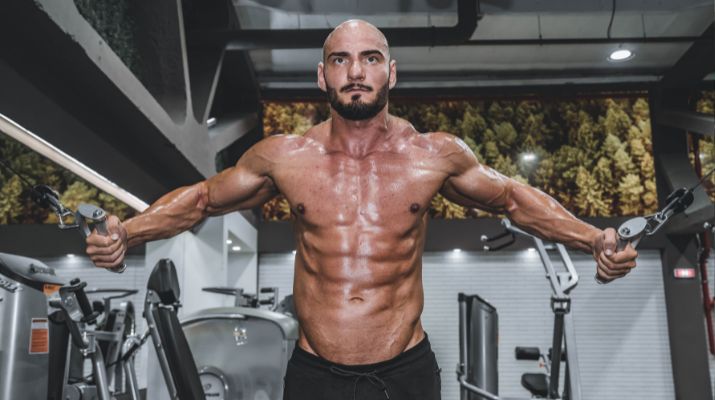
Source by pexel.com
How to do:
- Set pulleys on a cable machine to the highest level.
- Stand in the center with a handle in each hand.
- Step forward and lean slightly forward from the waist.
- With a gentle flex in your elbows, pull both handles down and in front of you, crossing one over the other.
- Slowly reverse the motion.
Sets or reps: 3-4 sets of 10-12 reps.
Expert advice: Maintain a steady core and avoid bending the elbows too much. Concentrate on squeezing the chest at the midpoint.
Benefits: The cable crossover efficiently targets the pectoral muscles, especially the outer and lower chest regions. The continuous tension from cables ensures constant muscle engagement.
Mistakes: Ensure you don’t lean too far forward or use momentum. Choose a weight that allows for a controlled movement.
Enhance your understanding of exercises leveraging continuous tension with our complete guide on resistance band exercises.
10. Landmine Press
How to do:
- Place one end of a barbell securely in a landmine attachment.
- Stand perpendicular to the bar, feet shoulder-width apart.
- Grip the free end of the barbell with one hand at chest height.
- Press the barbell upwards until your arm is fully extended.
- Return to the starting position.
Sets or reps: 3 sets of 8-10 reps per arm.
Expert advice: Maintain an upright posture and engage your core throughout. Ensure your wrist stays aligned with your forearm.
Benefits: The landmine press is a compound movement that primarily targets the upper chest and front deltoids. It provides an effective way to engage stabilizer muscles due to the unilaterality of the exercise.
Mistakes: Avoid rotating your body or leaning too far to one side.
Unilateral exercises can significantly improve muscle balance. Explore more about their importance in our article on Bulgarian squat and glute exercises.
11. Resistance Band Chest Press
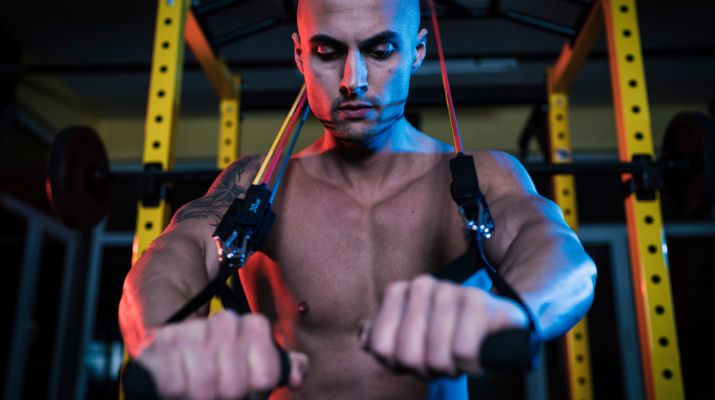
How to do:
- Wrap a resistance band around a sturdy post behind you.
- Grip each end of the band and step forward until there’s tension.
- Press both hands forward and together, mimicking a bench press movement.
- Slowly return to the starting position.
Sets or reps: 3-4 sets of 12-15 reps.
Expert advice: Maintain a firm stance and engage your core. Ensure the band’s tension is even on both sides.
Benefits: This exercise offers a versatile way to target the chest muscles without weights. The constant tension from the band ensures an effective workout for the pectorals.
Mistakes: Ensure the resistance band is securely fastened to avoid snapping. Also, don’t overstretch the band.
Delve deeper into the versatile world of resistance training with our comprehensive guide on wall pilates.
12. Plyometric Push-ups
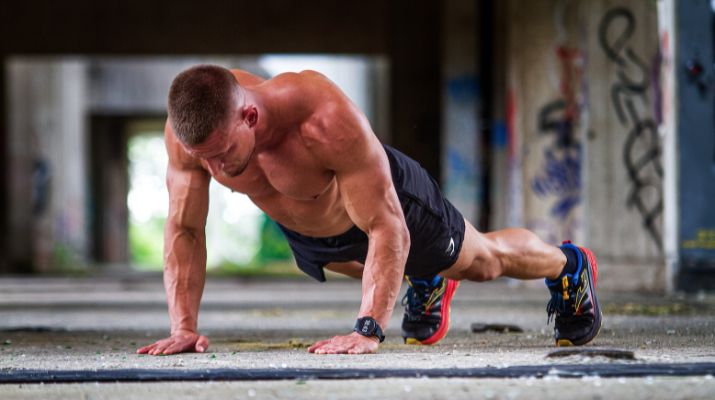
Source by pexel.com
How to do:
- Assume a standard push-up position, ensuring that your hands are positioned shoulder-width apart.
- Lower yourself as if you were performing a regular push-up.
- Explosively push yourself up so that your hands lift off the ground.
- Land softly and immediately lower yourself back into the push-up position.
Sets or reps: 3 sets of 6-8 reps.
Expert advice: Focus on landing gently to avoid wrist strain. Engage your core throughout to maintain stability.
Benefits: Plyometric push-ups are great for building explosive strength in the chest. They also engage the core, triceps, and shoulders.
Mistakes: Avoid locking out your elbows when landing. Make sure you maintain a straight line from head to heels.
For more on plyometric training and its benefits, check out our comprehensive guide on calisthenics workouts.
13. Chest Squeeze with Medicine Ball
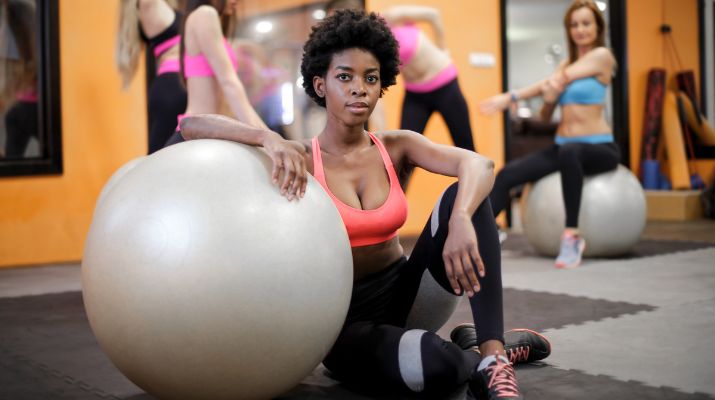
Source by pexel.com
How to do:
- Stand or sit upright, holding a medicine ball in front of you with both hands.
- Squeeze the ball as hard as you can, compressing it between your palms.
- Hold the squeeze for a few seconds and then relax.
Sets or reps: 3-4 sets of 10-15 squeezes.
Expert advice: Engage your chest muscles while squeezing rather than relying solely on hand and forearm strength.
Benefits: This exercise primarily targets the inner chest, helping in better pectoral muscle definition.
Mistakes: Using a ball that’s too large can strain wrists. Ensure you use a comfortable size for your hand span.
Enhancing muscle endurance is crucial. Learn more about the importance of targeted muscle training with our guide on nitric oxide dump exercises.
14. Single-arm Dumbbell Bench Press
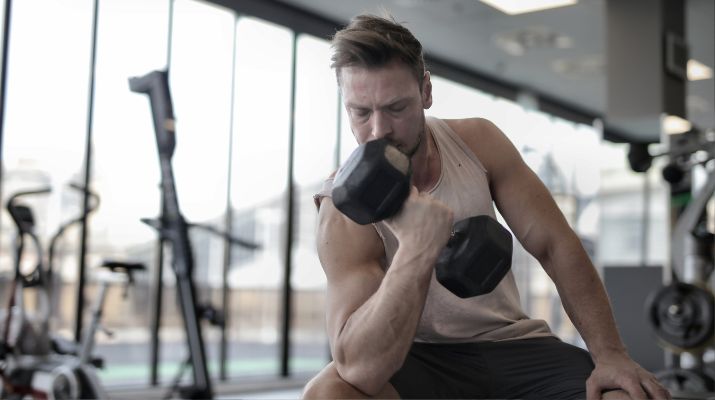
Source by pexel.com
How to do:
- Lie on a bench with a dumbbell in one hand.
- Hold the dumbbell above your chest with your arm fully extended.
- Lower the dumbbell to the side of your chest.
- Press the dumbbell back to the starting position.
Sets or reps: 3 sets of 8-10 reps per arm.
Expert advice: Keep the non-working hand on your hip or stretch out for balance. Engage your core to prevent your body from tilting to one side.
Benefits: The single-arm variant engages stabilizing muscles, offering a more challenging and balanced chest workout.
Mistakes: Avoid letting your hips or shoulders lift off the bench. Use a weight that allows for controlled movements.
Targeting individual muscle groups can result in more balanced muscle development. Discover the benefits of unilateral workouts in our guide on lunges exercises.
15. Floor Press
How to do:
- Lie on the floor with a dumbbell in each hand.
- Hold the dumbbells above your chest with arms fully extended.
- Lower the dumbbells until your upper arms touch the floor.
- Press the dumbbells back to the starting position.
Sets or reps: 3-4 sets of 10-12 reps.
Expert advice: The floor press, which limits the range of motion, can be advantageous for individuals experiencing shoulder problems. Keep your feet flat on the floor and drive through your triceps.
Benefits: This exercise targets the chest and triceps, emphasizing the lockout portion of a bench press.
Mistakes: Ensure your lower back remains in contact with the floor, maintaining a neutral spine.
Building foundational strength is essential. Dive deeper into the mechanics and benefits of foundational exercises with our guide on sumo deadlifts.
Standing Dumbbell Fly
The Standing Dumbbell Fly is an evolution of the traditional fly exercise but requires a different type of engagement. Standing while performing the fly movement requires the user to maintain a stable posture, engaging the core while allowing the pectoral muscles to take the brunt of the weight. This exercise is particularly useful in isolating the chest muscles, giving them a thorough workout.
Why Dumbbells are Essential for Chest Workouts
Dumbbells offer a unique kind of resistance training for chest exercises. Unlike machines, they allow a freer range of motion, enabling the user to work on stabilizing muscles that might be overlooked on a fixed machine. They also offer versatility in shifting weights and adjusting grips. This provides different levels of resistance and targets different parts of the chest, from the upper pectorals to the lower region.
Using dumbbells in your chest workouts ensures that both sides of your body get equal attention, reducing the risk of developing an imbalanced physique.
For a more comprehensive insight into the versatility and importance of dumbbells in strength training, dive into our guides on wrist curls and bicep curls.
The Role of Machines in Chest Development
While free weights like dumbbells offer flexibility and target stabilizing muscles, machines play a crucial role in chest development. They provide a controlled environment, making it safer for beginners and reducing the risk of injury. Machines isolate specific muscle groups, allowing the user to target and develop particular parts of the chest.
For those looking to gain mass or break past plateaus, machines can offer consistent resistance throughout the exercise motion, ensuring that muscles are continuously engaged. This is particularly useful for progressive overload, a key strategy in muscle development.
Understand the nuanced differences and benefits of various machines with our article comparing hack squat, leg press, and traditional squat.
Conclusion
Diverse chest workouts are paramount for holistic muscle development, strength, and aesthetic appeal. By incorporating a mix of free weights, bodyweight exercises, and machines, one ensures comprehensive muscle engagement, reduced risk of imbalances, and consistent progress. Always remember to listen to your body, maintain proper form, and prioritize safety to enjoy the lifelong benefits of fitness.
Interlink: If you’re keen on expanding your fitness horizon, our guide on calisthenics workouts can provide a refreshing bodyweight-centric approach to strength and flexibility.
Frequently Asked Questions (FAQs)
What is the one best exercise for the chest?
While it’s difficult to pinpoint a single “best” exercise since different exercises target various parts of the chest, many experts regard the bench press, especially its variations, as one of the most effective compound movements for overall chest development.
What exercise hits all of the chests?
The bench press, particularly in its flat form, engages a broad section of the chest. However, to ensure you hit all areas of the chest, it’s recommended to incorporate a variety of exercises, such as incline presses (for the upper chest), decline presses (for the lower chest), and flyes (to target the inner chest).
Which exercise hits the chest in the gym?
several exercises in the gym target the chest. Popular ones include the bench press, dumbbell press, cable crossover, and pec deck machine. Incorporating a mix of these exercises ensures comprehensive chest development.
How often should you train your chest for best results?
For most individuals, training the chest 1-2 times per week is sufficient. It’s crucial to allow muscles to recover adequately between sessions. The exact frequency depends on your goals, workout intensity, and individual recovery rate.
Are machines or free weights better for chest development?
Both machines and free weights offer unique benefits. Machines provide controlled movement, reducing the risk of injury, especially for beginners. On the other hand, free weights, like dumbbells, engage stabilizing muscles and offer a wider range of motion. For holistic chest development, it’s beneficial to incorporate both into your routine.

